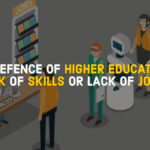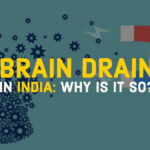The technology can be leveraged as an effective instrument for enhancing the quality, but it is too simplistic to deduce that future education shall be all virtual with no place for the brick and mortar universities.
As COVID-19 compelled lockdown about a year ago, the campus came to an abrupt halt. They have largely remained out of bound since then. However, the teaching-learning process was continued by leveraging technology. Lectures were ‘Zoomed’, tutorials took place on ‘Microsoft Team’, interviews and interactions held on ‘Google Meet’, and ‘Cisco Webcast’, and all these tools were used interchangeably. Suddenly, social media became a potent platform for live-streaming disseminating knowledge. Assignments were sent and received on ‘Google Classroom’ and laboratories went virtual. Webinars, a new entrant in the higher education lexicon replaced seminars and conferences. Apparently, the pandemic accomplished in weeks what technology touts couldn’t in decades.
Also Read: Challenges in Handling Disruption in Education during COVID-19
Encouraged by the rapidity with which campuses migrated from physical to virtual, the technology enthusiasts are already busy writing the obituary of the brick-and-mortar types of colleges and universities. To them the higher education activities and processes would disappear from physical space sooner than anticipated and that the transitions from physical to virtual would be total and absolute. Those in disagreement are labelled as techno-probes and sceptics. The best guess at the moment is that universities in their present form would not vanish but they shall return back to a new normal with a high degree of technology blending in their teaching, learning, and research processes.
Universities in their present form would not vanish but they shall return back to a new normal with a high degree of technology blending in their teaching, learning, and research processes.
Techno enthusiasts cite rapid technological advancements with immense potentials and possibilities abetting the transition in the higher education system. Digital divided perpetuated by restricted access to electricity by a sizeable section of the society could well be a lament of the past. The manmade sun could soon become a perpetual source of energy at a frugal fare. The bandwidth limitations could be overcome with a super speed network beamed from outer space enabling access all across the nooks and corners of the universe. Digital divide thus addressed, nothing shall come in the way of technology-aided teaching with Artificial Intelligence (AI) and Machine Learning (ML) playing a major role, leading to mass-scaling of the teaching, learning, examination, and evaluation processes, and thereby obviating the need to restrict the intake capacity of the higher educational institutions. And it is at this point that the transformative potential of the technology might turn disruptive.
Also Read: 2020: A Year of Shambolic Education Burdening Learners
With restrictions on the intake ceiling removed, all higher educational institutions shall be free to admit as many students as they wish. As a result, learners from low-ranked poor quality institutions would migrate in hordes to the top-ranked universities. With fewer or no students left on their roll, most such institutions would close down, consolidate, merge, or get settled as lifelong learning and skill augmenting tertiary higher educational institutions. Simultaneously, the social media and apps would emerge as a dominant player in career guidance and counselling, advising potential learners with AI-curated courses customised for their individual inclinations, aptitude, and need.
Also Read: Ensuring Education to Poor in Post-Pandemic Era
Further advancements may, in fact, unshackle students from the clutches of a single university. Students would now be able to accumulate credits on an anytime-anywhere basis from a wide variety of humongous open online modules offered by humans, humanoids, and cyborgs accredited by a competent higher education qualification authority with a universal mandate to enable seamless access and portability of qualifications throughout the universe. Plausibly, the institutional authority would finally get replaced by individual sovereignty. Expectedly, even the top-ranked universities would loose their relevance. They may become redundant with the launch of a higher education qualification authority to assesses and awards qualifications. With the qualifications coming with an expiry date, people in the working-age groups will be in a perpetual knowledge up-gradation mode.
With the qualifications coming with an expiry date, people in the working-age groups will be in a perpetual knowledge up-gradation mode.
These possibilities and potentials in the realm of reality notwithstanding, realities on the ground are starkly different. The transition from physical to virtual is as yet a predominantly a metropolitan narrative. Speaking of India, a continent-sized country with over 37 million students enrolled in about 52,000 higher educational institutions, an overwhelming majority of the higher educational institutions could migrate to the only primitive form of online learning, where only a semblance of teaching-learning took place. Most of these were located in remote and rural areas with limited means. The worst affected have been those with limited means.
Technology has certain inherent deficiencies leading to serious compromises in the teaching-learning processes.
Virtually (!) most stakeholders including even the premier higher educational institutions, feel that online teaching is, at best a time-gap arrangement. They seem convinced that technology has certain inherent deficiencies leading to serious compromises in the teaching-learning processes. Universities are, therefore, expected to bounce back to their usual ways as soon as the circumstances permit. They might blend virtual learning to some extent with their conventional mode of imparting instructions. After all, universities have historically embraced technologies without any paradigmatic shift in their approach to teaching and research. Teachers survived textbooks. Broadcast and telecast technologies could not make classrooms redundant. Massive investments and sustained campaigns for promoting digital learning and MOOCs have hardly impacted conventional universities any adversely.
Massive investments and sustained campaigns for promoting digital learning and MOOCs have hardly impacted conventional universities any adversely.
The crisis could catalyse change but only for the interim. Recall the plagues in Europe that recurred repeatedly during the 14th to 17th centuries that would force students and faculty to flee their campuses to take refuge in the countryside manor houses. For Isaac Newton, one such escape may have proven to be the most productive period of his life, but the countryside manor houses could never become academies in perpetuity. The Spanish Flu of 1918 affected close to 20 million people in India but the decadal census data for the years 1911 and 1921 shows a significant increase in the number of universities, colleges, and students. Importantly, the newer universities were no different than their counterparts before the pandemic.
A classroom is never as simple as Zoom imagines and where the teachers could mute the class at the click of a button.
Universities are not only about teaching and learning. They mean much more than that. Campuses attract learners and the learned because human nature seeks companionship with contemporaries. But they go far beyond than being places of socialisation, hanging around and making and meeting friends. They rather transcend to enable experiential learning by being in the company of not only the like-minded but also those with drastically differing views. It is for the discussion, discourse, and dissent that the students and scholars long for being on the campus. A classroom is never as simple as Zoom imagines and where the teachers could mute the class at the click of a button.
Also Read: Work-life balance of teachers in digital learning environment
No wonder, universities have remained fundamentally unchanged over centuries. They are unlikely to change significantly post-Covid19 and it shall not be due to the resistance to change but because of certain inherent but invisible features that define universities which technology has so far failed to capture. Technology did provide an alternative in the time of crisis and could be leveraged as an effective instrument for enhancing the quality and promoting excellence. It may, however, be too simplistic to deduce that the future of higher education shall be all virtual with no place for the brick and mortar universities.
Disclaimer: The views expressed in this article are of the author solely. TheRise.co.in neither endorses nor is responsible for them.
About the author
Dr. Furqan Qamar is a former professor of management at Jamia Millia Islamia and an education advisor in the Planning Commission, now NITI Aayog, is currently the Chief Advisor to the Chancellor at Integral University, Lucknow. He has been the former Vice-Chancellor of the University of Rajasthan and Central University of Himachal Pradesh and Secretary General of Association of Indian Universities..









































Pingback: Technological Transformation in Higher Education – Prof. Furqan Qamar
Very well written. Technology despite its limitations shall play an important role in radically reforming higher education and make teaching learning more fulfilling and rewarding.
Imcreasing use of technology in university and institutional management shall create transparency, beedout corruption and create trust of the stakeholders. It will also nurture integrity of information and enforce professional morals so much needed in education sector that preaches integrity and morality.
In a connected world, learning from anywhere any time and any thing as per interest shall also become a reality as we move deeper into the digital transformation in Higher Education.
Good to see the balanced view at a time when the use of technology is being wrongly perceived as a substitute to traditional processes by many in influential roles. Let us hope that the use of technology remains merely to supplement teaching-learning and associated processes. Serious academics should come forward for safeguarding the conventional teaching blended with the use of technology for improving its efficacy. There is lesser hope from the present-day academic leadership which at times does not value the importance of teaching-learning processes.
Pingback: Schools becoming Garden of Selfish Giant! - TheRise.co.in
Pingback: Supreme Court on Access to Education - TheRise.co.in
Pingback: Impact of Technology and Innovations on Humans - TheRise.co.in